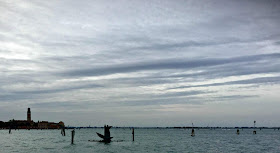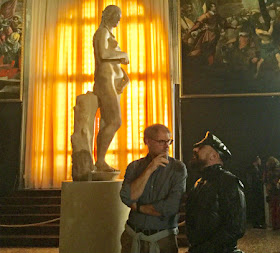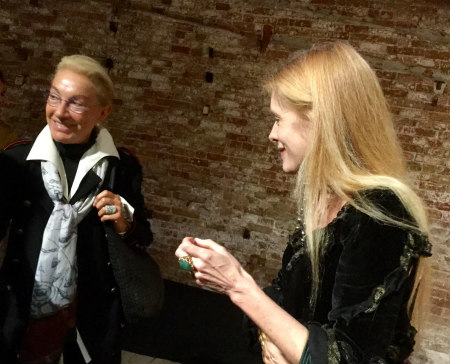 |
| Strolling under the pergola - Opening of the Giardini Royali in Venice - Photo: Cat Bauer |
A BRIEF HISTORY OF THE ROYAL GARDENS IN VENICE
After Napoleon had conquered Venice, he thought that the perfect complement to his new Royal Palace in the Procuratie Nuove in Piazza San Marco would be a Royal Garden. So he had the 14th century public granaries knocked down, where the Venetian Republic had stocked their wheat.
That was the beginning of the Royal Gardens, which are on an island surrounded by canals and the Basin of St. Mark. Created on the initiative of Napoleon and Viceroy Eugene de Beauhamais, son of Napoleon's wife Joséphine, the gardens and royal residence were initially designed by the architect Giovanni Antonio Antolini. Viceroy Beauhamais changed Antolini's approach, and subsequently Antolini's son-in-law, the engineer Giuseppe Mezzani, reworked the plans, overseen by Royal Architect Luigi Canonica. After a series of delays and disagreements, next up was the architect Giuseppe Maria Soli.
From 1797, Venice had been tossed back and forth under French domination, then Austrian, then French, then Austrian again as the garden was being developed. When the dust settled, a drawbridge had been built in 1815 over a small internal canal to provide access to the gardens from the Royal Palace, which also allowed gondolas to glide by.
By then, the architect Lorenzo Santi had been put in charge of the Royal Palace construction, recommended by the great artist Antonio Canova himself. It was Santi who put the final touches on the gardens, complete with a wooded grove, flowering plants, greenhouse, potted citrus trees and a tree-lined avenue along the Basin of St. Mark. At the end of the avenue, Santi placed the Cafehaus, a neoclassical pavilion. All this was off limits to the public and reserved for the court.
The Generali Group is the main partner in today's restoration project thanks to incentives from Art Bonus, which gives tax credits to those who support culture with charitable donations. The Generali Group was founded in Trieste in 1831. The next year, they opened an office in Venice in Piazza San Marco in the Procuratie Vecchie building, which is where they are still located today. Generali is a major player in the global insurance market. .
Venice was not thrilled to be under the rule of Austria, and revolted in 1848 under the revolutionary leader Daniele Manin, a jurist and passionate statesman. Generali was sympathetic to the cause, and took the winged Lion of San Marco as their symbol rather than the Hapsburg eagle. They did this right under the nose of the Austrians who were located next door in the Royal Palace aka the Procuratie Nuove in Piazza San Marco.
In 2017 I wrote a post which gives the layout of the land, and which I strongly suggest you read, that gives more details.
The Venetians briefly drove out the Austrians and elected Daniele Manin as president of the re-created Republic of Venice. But the Austrians came roaring back and re-took Venice in 1849.
Needless to say, the Venetians were enraged. To calm everybody down, in 1857 Emperor Franz Joseph allowed the public to walk along the avenue flanking the Basin of St. Mark, but they could not go inside the gardens, which were used exclusively by the court. So iron bars were built to separate the path from the gardens. (Can you imagine such a thing? The Venetian public were given permission to walk along their own lagoon while the Austrians partied inside the barred-off garden.)
But now that the public could walk along the avenue, where was the court supposed to stroll? To solve that problem, an iron and cast iron pergola that ran the length of the gardens was constructed to provide a shaded private walk, adapted from a temporary one that had been built to welcome Emperor Franz Joseph and Empress Sissi when they had first arrived on the scene in November 1856. But when Sissi lived by herself in the Royal Palace in Venice from October 1861 to May 1862, she revoked the permission. (If you visit the Correr Museum, which is what the wing of the Royal Palace morphed into, you can look out Sissi's windows and pretend you are an empress trapped in her rooms.)
In 1866, Venice became part of the Kingdom of Italy, and the Savoy monarchs let the public walk along the edge of the water again. In fact, an iron bridge was built so it could be accessed from Piazzetta di San Marco. The drawbridge connecting the gardens to the palace was rebuilt in 1893.
After World War I, on December 23, 1920, the Crown ceded the Royal Gardens to the State Property Office, which entrusted them to the City of Venice, who threw the gates wide open. They also opened the drawbridge in the former Royal Palace, so you could stroll right from Piazza San Marco into the gardens.
Then Mussolini came along and suspended the drawbridge. And then the Nazis came to town.
During World War II, a concrete bunker was constructed right in the central area of the gardens.
After the war, as the decades progressed, the gardens were neglected until the pergola was in ruins, the drawbridge unusable -- frozen in a raised position -- the gate rusted and crumbling, the trees diseased, and the greenery and flowers wild and chaotic. Hordes of tourists invaded the gardens, munching on sandwiches and drinking Coke. The Cafehaus had transformed from coffeehouse to headquarters of the Bucintoro Rowing Club, to air terminal(!), to an info point for the tourist office until it was closed and abandoned. The whole place was a wreck.
On December 23, 2014, the State Property Office entrusted the management of the Royal Gardens to the Venice Garden Foundation, who began its recovery, and is now responsible for its care and conservation.
On December 19, 2019, the Royal Gardens re-opened to the public. Paolo Pejrone, the renowned landscape architect in charge of the garden project said, "It takes a lot of courage to create a garden like this, and even more courage to open it in the middle of December. Creating a garden in a lagoon is not easy."
Why didn't the gardens flood during the Acqua Granda of November 12? Especially because they are located between Piazza San Marco, Venice's lowest point, and the mouth of the Grand Canal? Pejrone said it was because Napoleon, foresighted emperor that he was, ordered them built high to protect them from flooding. Pejrone is also looking to the future, and populated the gardens with sustainable plants, shrubs and trees that require little water and provide plenty of shade.
Luigi Brugnaro, the Mayor of Venice, was at the inauguration and said that the project had the full support of the current administration. Dario Franceschini, the Italian Minister of Culture, was also on hand and said, "It is a beautiful story of love and generosity."
The Cafehaus is once again a coffeehouse and eatery, thanks to the support of the Italian family-owned company, illycaffè. Andrea Illy, the chairman of the premium coffee company and grandson of the founder, was at the inauguration. (If you haven't heard of illycaffè before, you could soon, as they are considering expanding into the United States.) The elegant pavilion of Istrian stone was restored to its former glory
under the direction of the Venetian architect, Alberto Torsello.
The first thing I did after the press conference was head over to the newly restored drawbridge and take a photo. It was a thrill to walk from the gardens right into Piazza San Marco.
The Royal Gardens are located in one of Mediterranean Europe's most important bird areas, which will be a small oasis where resident birds can build their nests and where birds migrating to East-Central Europe can rest before continuing on their journeys. There are two beehives that will make it possible to witness the behavior of those fascinating creatures up close and personal.
The concrete bunker was demolished. The pergola was rebuilt. The greenery and flowers restored with:
New plantings:
22 trees;
804 shrubs;
6,560 flowering plants;
3,150 bulbs;
68 climbing plants.
Trees being treated: 7
Diseased or dead trees replaced: 19
Philippe Bonnet, the CEO of Generali Group, was also at the inauguration, and said their work was only partially complete. Generali wants to cure the planet, and is restoring the Procutarie Vecchie, with a design by David Chipperfield, which will house its ambitious "Human Safety Net" project. The Human Safety Net supports families, children and vulnerable communities, and is a movement of people helping people, "inspired by the idea of ‘chain aid’, where those
who benefit may one day give back to someone else, creating a ‘ripple’
of positive change that extends worldwide with limitless potential."
The Procutarie will be open to the public for the first time in 500 years, and will include exhibition spaces, offices, workshops and an auditorium. The restoration will use original Venetian materials and craftsmanship from local tradespeople.
When the entire project is complete, Piazza San Marco will be utterly transformed, all the way to the edge of the lagoon, welcoming the public with open arms. Let's hope the public responds with respect and appreciation, and treats Venice with the dignity she deserves.
Ciao from Venezia,
Cat Bauer
Venetian Cat - The Venice Blog
After Napoleon had conquered Venice, he thought that the perfect complement to his new Royal Palace in the Procuratie Nuove in Piazza San Marco would be a Royal Garden. So he had the 14th century public granaries knocked down, where the Venetian Republic had stocked their wheat.
That was the beginning of the Royal Gardens, which are on an island surrounded by canals and the Basin of St. Mark. Created on the initiative of Napoleon and Viceroy Eugene de Beauhamais, son of Napoleon's wife Joséphine, the gardens and royal residence were initially designed by the architect Giovanni Antonio Antolini. Viceroy Beauhamais changed Antolini's approach, and subsequently Antolini's son-in-law, the engineer Giuseppe Mezzani, reworked the plans, overseen by Royal Architect Luigi Canonica. After a series of delays and disagreements, next up was the architect Giuseppe Maria Soli.
From 1797, Venice had been tossed back and forth under French domination, then Austrian, then French, then Austrian again as the garden was being developed. When the dust settled, a drawbridge had been built in 1815 over a small internal canal to provide access to the gardens from the Royal Palace, which also allowed gondolas to glide by.
 |
| Royal Gardens in Venice in the 19th Century |
The Generali Group is the main partner in today's restoration project thanks to incentives from Art Bonus, which gives tax credits to those who support culture with charitable donations. The Generali Group was founded in Trieste in 1831. The next year, they opened an office in Venice in Piazza San Marco in the Procuratie Vecchie building, which is where they are still located today. Generali is a major player in the global insurance market. .
Venice was not thrilled to be under the rule of Austria, and revolted in 1848 under the revolutionary leader Daniele Manin, a jurist and passionate statesman. Generali was sympathetic to the cause, and took the winged Lion of San Marco as their symbol rather than the Hapsburg eagle. They did this right under the nose of the Austrians who were located next door in the Royal Palace aka the Procuratie Nuove in Piazza San Marco.
In 2017 I wrote a post which gives the layout of the land, and which I strongly suggest you read, that gives more details.
Did you know there are Royal Gardens in Venice? You will soon!
The Venetians briefly drove out the Austrians and elected Daniele Manin as president of the re-created Republic of Venice. But the Austrians came roaring back and re-took Venice in 1849.
Needless to say, the Venetians were enraged. To calm everybody down, in 1857 Emperor Franz Joseph allowed the public to walk along the avenue flanking the Basin of St. Mark, but they could not go inside the gardens, which were used exclusively by the court. So iron bars were built to separate the path from the gardens. (Can you imagine such a thing? The Venetian public were given permission to walk along their own lagoon while the Austrians partied inside the barred-off garden.)
 |
| View from Sissi's window in Museo Correr on Dec 4, 2019 - Photo: Cat Bauer |
In 1866, Venice became part of the Kingdom of Italy, and the Savoy monarchs let the public walk along the edge of the water again. In fact, an iron bridge was built so it could be accessed from Piazzetta di San Marco. The drawbridge connecting the gardens to the palace was rebuilt in 1893.
After World War I, on December 23, 1920, the Crown ceded the Royal Gardens to the State Property Office, which entrusted them to the City of Venice, who threw the gates wide open. They also opened the drawbridge in the former Royal Palace, so you could stroll right from Piazza San Marco into the gardens.
Then Mussolini came along and suspended the drawbridge. And then the Nazis came to town.
During World War II, a concrete bunker was constructed right in the central area of the gardens.
After the war, as the decades progressed, the gardens were neglected until the pergola was in ruins, the drawbridge unusable -- frozen in a raised position -- the gate rusted and crumbling, the trees diseased, and the greenery and flowers wild and chaotic. Hordes of tourists invaded the gardens, munching on sandwiches and drinking Coke. The Cafehaus had transformed from coffeehouse to headquarters of the Bucintoro Rowing Club, to air terminal(!), to an info point for the tourist office until it was closed and abandoned. The whole place was a wreck.
On December 23, 2014, the State Property Office entrusted the management of the Royal Gardens to the Venice Garden Foundation, who began its recovery, and is now responsible for its care and conservation.
 |
| Inauguration of Venice Royal Gardens - Photo: Cat Bauer |
Why didn't the gardens flood during the Acqua Granda of November 12? Especially because they are located between Piazza San Marco, Venice's lowest point, and the mouth of the Grand Canal? Pejrone said it was because Napoleon, foresighted emperor that he was, ordered them built high to protect them from flooding. Pejrone is also looking to the future, and populated the gardens with sustainable plants, shrubs and trees that require little water and provide plenty of shade.
Luigi Brugnaro, the Mayor of Venice, was at the inauguration and said that the project had the full support of the current administration. Dario Franceschini, the Italian Minister of Culture, was also on hand and said, "It is a beautiful story of love and generosity."
 |
| The Coffee House at Royal Gardens - Photo: Cat Bauer |
 |
| Standing on the drawbridge - Photo: Cat Bauer |
The Royal Gardens are located in one of Mediterranean Europe's most important bird areas, which will be a small oasis where resident birds can build their nests and where birds migrating to East-Central Europe can rest before continuing on their journeys. There are two beehives that will make it possible to witness the behavior of those fascinating creatures up close and personal.
The concrete bunker was demolished. The pergola was rebuilt. The greenery and flowers restored with:
New plantings:
22 trees;
804 shrubs;
6,560 flowering plants;
3,150 bulbs;
68 climbing plants.
Trees being treated: 7
Diseased or dead trees replaced: 19
 |
| Philippe Bonnet & Adele Re Rebaudengo - Photo: Cat Bauer |
The Procutarie will be open to the public for the first time in 500 years, and will include exhibition spaces, offices, workshops and an auditorium. The restoration will use original Venetian materials and craftsmanship from local tradespeople.
When the entire project is complete, Piazza San Marco will be utterly transformed, all the way to the edge of the lagoon, welcoming the public with open arms. Let's hope the public responds with respect and appreciation, and treats Venice with the dignity she deserves.
ROYAL GARDENS OPENING HOURS
Open from Tuesday to Sunday:
from April 15 to October 15, 8.30 a.m. - 7.30 p.m. (last entry at 7.15 p.m.)
from October 16 to April 14, 9.00 a.m. - 5.00 p.m. (last entry at 4.45 p.m.)
The Gardens are closed: Mondays, December 25 and 31, January 1, the last Saturday and last Sunday of Carnival, Easter Sunday, Saturday during the Feast of the Redeemer (3rd Saturday in July).
Ciao from Venezia,
Cat Bauer
Venetian Cat - The Venice Blog
































